Choosing the Right Crane: Bridge Crane vs. Gantry Crane
The Vital Role of Cranes in Modern Industries
In the ever-evolving landscape of modern industries, the role of cranes cannot be overstate These formidable machines are the unsung heroes behind the scenes, ensuring that heavy materials are lifted, transported, and positioned with precision. Whether it's the assembly line of a manufacturing plant, the bustling activity of a construction site, or the seamless logistics of a warehouse, overhead cranes play a pivotal role in ensuring operations run smoothly and efficiently.
At Yuantai Crane, we understand the challenges and opportunities that come with choosing the right crane for your specific needs. As a trusted crane manufacturer and supplier, we've crafted this comprehensive guide to help you navigate the world of overhead cranes. We aim to provide valuable insights into the different types of overhead cranes, their features, benefits, typical applications, and much more.
Overhead Crane Basics
In the realm of industrial innovation, where precision meets power, overhead cranes stand as stalwart workhorses. As we delve deeper into the fundamental aspects of these extraordinary machines, we gain a profound appreciation for their role in transforming the landscape of modern industries.
What Are Overhead Cranes?
Definition and Purpose
Definition: At its core, an overhead crane is a mechanical apparatus engineered for the seamless lifting, transportation, and precise positioning of hefty loads. Its design comprises a horizontal bridge beam, a robust hoist mechanism, and a mobile trolley, all meticulously synchronized to execute material handling tasks with unrivaled accuracy.
Purpose: The primary purpose of an overhead crane is to shoulder the heavy burden of lifting and moving bulky objects. From manufacturing facilities to construction sites and beyond, these mechanical marvels are indispensable in streamlining operations that rely on the movement of significant loads.
Types of Bridge Cranes
The main types of bridge cranes, also known as overhead cranes or bridge girder cranes, are distinguished based on their configuration and application. Here are the main types:
- Single Girder Bridge Cranes:- Features: Single horizontal girder supports the hoist and trolley. Lightweight construction. - Applications: Ideal for smaller capacity lifting needs in warehouses, workshops, assembly lines, and outdoor material storage yards.
- Double Girder Bridge Cranes:- Features: Two horizontal girders support the hoist and trolley. Robust construction with high load-bearing capacity. - Applications: Used in heavy-duty lifting tasks in industries such as steel mills, ports, power plants, and automotive manufacturing.
- Top Running Bridge Cranes:- Features: Run on tracks or runways installed on the top of the building structure. Suitable for environments with limited floor space. - Applications: Commonly found in manufacturing facilities, aerospace industry, and paper mills.
- Under Running Bridge Cranes (Underhung Cranes):- Features: Hang from the building structure, typically with wheels running on a bottom flange track. Suitable for facilities with limited headroom. - Applications: Used at workstations, cleanrooms, and laboratories where overhead clearance is limite
- Workstation Bridge Cranes (Monorail Cranes):- Features: Compact systems designed for individual workstations. Can be either ceiling-mounted or freestanding.- Applications: Found in assembly stations, maintenance workstations, and loading docks.
Each type of bridge crane has its own advantages and is chosen based on factors such as load capacity, workspace layout, and the specific material handling requirements of the industry or facility. These cranes are versatile and can be customized to meet various operational needs.
Applications of bridge cranes
Bridge cranes, due to their versatility and ability to handle heavy loads, find applications across various industries. Here are some typical applications of bridge cranes:
- Manufacturing Facilities: Bridge cranes are widely used in manufacturing for lifting and moving heavy materials and components. They are essential in assembly lines for positioning parts and aiding in the manufacturing process.
- Warehouses and Distribution Centers: In warehouse environments, bridge cranes help with efficient material handling, such as loading and unloading trucks, stacking pallets, and moving goods within the facility.
- Automotive Industry: Bridge cranes play a crucial role in the automotive industry, where they are used to lift and position car components during assembly. They are also used in automotive plants for die handling and maintenance tasks.
- Steel Mills: Heavy-duty double girder bridge cranes are employed in steel mills for handling large steel coils, sheets, and other heavy materials. They are essential for steel manufacturing and processing.
- Ports and Shipyards: In port facilities, bridge cranes, especially large gantry cranes, are used for loading and unloading cargo from ships. They also help manage storage yards for containers and bulk materials.
- Power Plants: Bridge cranes are used in power plants for maintenance, repairs, and the installation of heavy machinery and equipment. They aid in handling generators, turbines, and other components.
- Aerospace Industry: The aerospace sector relies on bridge cranes for lifting and positioning aircraft components and engines. They are essential for assembling and maintaining aircraft.
- Paper Mills: Bridge cranes are used in paper mills to lift and transport heavy paper rolls and equipment. They help streamline paper manufacturing processes.
- Construction Sites: On construction sites, bridge cranes assist in lifting and placing construction materials, such as steel beams, concrete blocks, and precast elements.
- Mining Industry: In mining operations, bridge cranes are used for various tasks, including moving heavy machinery, transporting ore, and maintenance of mining equipment.
- Foundries: Bridge cranes are integral in foundries for handling molten metal, molds, and casting equipment. They aid in the production of metal components and parts.
- Automated Storage and Retrieval Systems (AS/RS): Bridge cranes are central components of AS/RS systems in warehouses and distribution centers. They efficiently retrieve and store goods in high-bay storage racks.
- Cleanrooms and Laboratories: In cleanroom environments and laboratories, bridge cranes are used for precise and controlled material handling, especially when dealing with sensitive and delicate equipment.
- Entertainment Industry: In the entertainment industry, bridge cranes are employed for rigging and suspending lighting and audio equipment in theaters, concert halls, and event venues.
- Food Processing: Bridge cranes assist in food processing facilities for lifting and moving ingredients, equipment, and packaging materials.
These are just a few examples of the diverse applications of bridge cranes. Their adaptability and ability to handle heavy loads make them essential tools in industries where efficient material handling is critical.
Bridge Cranes: Main Types, Features, Benefits, and Applications
As we embark on our journey through the diverse world of bridge cranes, we encounter a spectrum of options that cater to specific industrial demands. Bridge cranes, known for their unwavering strength and precision, come in various configurations, each tailored to excel in distinct material handling scenarios.
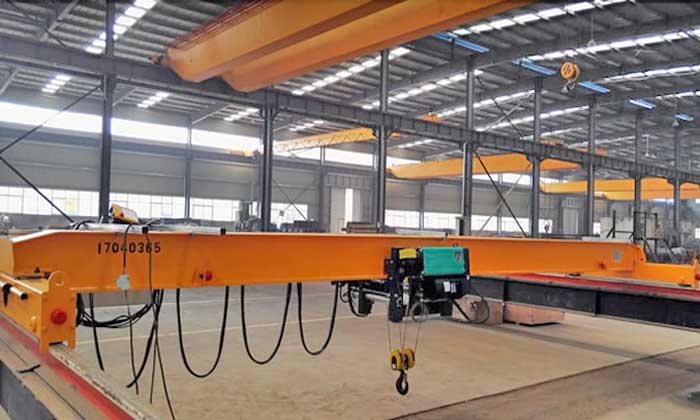
Single Girder Bridge Cranes 1 ton - 20 ton
Features
Single girder bridge cranes embody simplicity without compromising on strength. Their features include:
- A single horizontal beam (girder) that supports the hoist and trolley.
- A compact design that excels in smaller workspaces.
- Cost-effective solutions for moderate lifting requirements.
Benefits
The benefits of single girder bridge cranes extend beyond efficiency:
- Cost-effectiveness: Ideal for businesses seeking an economical lifting solution.
- Limited headroom requirements: Suitable for facilities with space constraints.
- Versatility: Adaptable for manual, semi-automated, or fully automated operations.
Typical Applications
Single girder bridge cranes find their niche in a range of industrial settings:
- Warehouses: Efficiently moving goods and materials within limited spaces.
- Workshops: Assisting in assembly processes and equipment maintenance.
- Small manufacturing operations: Supporting production processes with precision.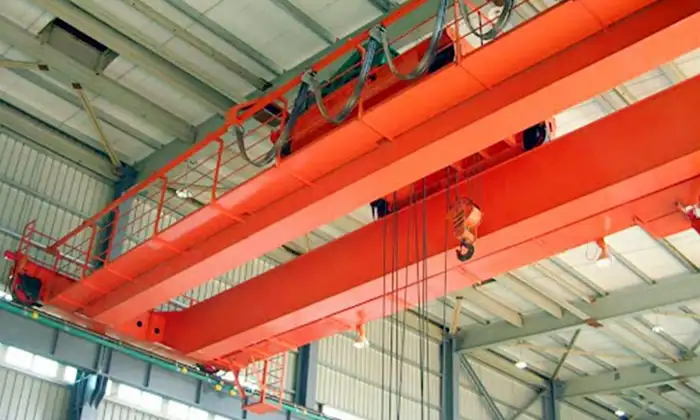
Features
Double girder bridge cranes take strength and load-bearing capacity to the next level:
- Two horizontal girders supporting the hoist and trolley.
- Enhanced stability for heavy-duty lifting tasks.
- Designed for demanding industrial environments.
Benefits
Double girder bridge cranes offer an array of advantages:
- High load capacity: Perfect for lifting heavy materials and equipment.
- Durability: Resilient in harsh industrial conditions.
- Capability for complex lifting tasks: Handling large and intricate loads with ease.
Typical Applications
These powerhouse cranes are indispensable in industries that demand sheer strength:
- Steel mills: Handling massive steel components with precision.
- Foundries: Safely moving molten metal and heavy castings.
- Aerospace manufacturing: Supporting the assembly of aircraft components.
- Heavy machinery production: Ensuring the seamless assembly of industrial equipment.

Top Running Bridge Cranes
Features
Top running bridge cranes epitomize efficiency and precision:
- Rails or runway beams mounted on top of structures for crane movement.
- Maximization of overhead space for material handling.
- Versatility to incorporate advanced automation and safety features.
Benefits
The advantages of top running bridge cranes are pivotal to streamlined operations:
- Efficient use of overhead space: Ideal for congested manufacturing facilities.
- Flexibility: Adaptable for various industries and applications.
- Potential for automation: Integration with cutting-edge systems for seamless workflow.
Typical Applications
Top running bridge cranes shine in settings that demand optimization:
- Large manufacturing facilities: Ensuring efficient material handling.
- Automotive production lines: Facilitating the assembly of vehicles.
- Paper mills: Safely transporting heavy paper rolls.
- Storage warehouses: Maximizing vertical storage capacity.
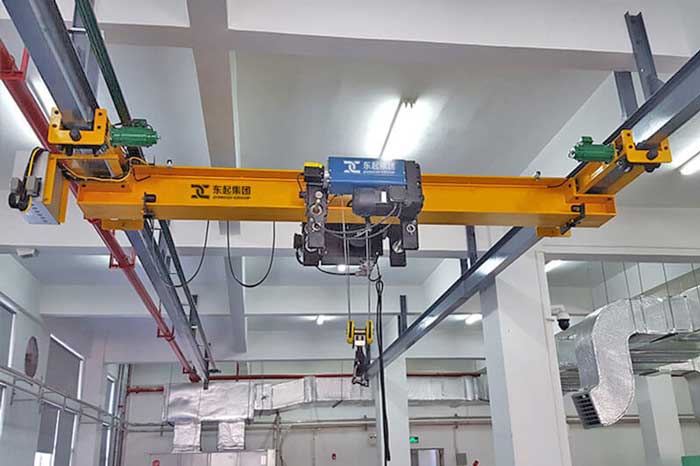
Under Running Bridge Cranes (Underhung Cranes)
Features
Under running bridge cranes thrive in environments with limited headroom:
- Cranes that hang from structures and move along rails beneath them.
- Excellent for applications where overhead space is scarce.
- Precision in confined spaces for material handling.
Benefits
These cranes offer a unique set of benefits:
- Effective use of limited vertical space: Suitable for low headroom applications.
- Ideal for precise material handling: Navigating confined work areas with ease.
- Efficiency in areas with structural constraints: Adaptable to tight spaces.
Typical Applications
Under running bridge cranes are pivotal in industries with spatial challenges:
- Clean rooms: Maintaining precision in controlled environments.
- Food processing plants: Safely handling delicate food products.
- Electronics manufacturing: Precision in the assembly of sensitive electronics.
- Laboratories: Ensuring precision in research and development.
Stay with us on this illuminating journey through the world of bridge cranes as we explore their features, benefits, and applications. These cranes, with their diverse configurations, continue to be the backbone of industries worldwide, making the seemingly impossible a reality.
Gantry Crane Basics
Gantry cranes are engineering marvels designed to tackle heavy lifting and material handling tasks with precision and versatility. In this section, we will delve into the fundamental aspects of gantry cranes, exploring their definition, key features, benefits, and typical applications.
What Are Gantry Cranes?
Definition and Purpose
Definition: Gantry cranes are robust and versatile material handling machines characterized by their sturdy, upright steel legs or supports and a horizontal bridge beam that spans the gap between these legs. This bridge houses a hoist and trolley mechanism, enabling the crane to lift, move, and position heavy loads with ease.
Purpose: The primary purpose of a gantry crane is to provide a reliable and efficient means of lifting and transporting heavy objects in a wide range of industrial and commercial settings. Gantry cranes are indispensable tools for enhancing material handling operations.
Types of Gantry Cranes
Gantry cranes come in various configurations, each tailored to specific lifting requirements and operational environments. The main types include:
- Single Girder Gantry Cranes: These cranes feature a single horizontal beam (girder) supporting the hoist and trolley. They are suitable for moderate lifting needs.
- Double Girder Gantry Cranes: With two horizontal girders, these cranes offer higher load capacities and increased stability, making them ideal for heavy-duty applications.
- Rubber-Tired Gantry Cranes (RTGs): RTGs are mobile gantry cranes mounted on rubber tires, providing excellent maneuverability and often used in container handling.
- Rail-Mounted Gantry Cranes (RMGs): RMGs run on rails for precise movement and positioning, making them a popular choice in container terminals and automated storage systems.
Gantry cranes exhibit diverse types, configurations, and mobility options. These characteristics empower them to excel in various industrial domains, adapting to specific material handling needs.
Benefits of Using Gantry Cranes
Gantry cranes bring a multitude of benefits to the table, enhancing efficiency, safety, and productivity in material handling operations. Key advantages include:
- Efficiency: Gantry cranes streamline material handling processes, reducing manual labor and optimizing workflow.
- Safety: They come equipped with safety features such as limit switches, emergency stop buttons, and anti-collision systems to ensure secure operations.
- Productivity: Gantry cranes are known for their speed and precision, enabling faster and more accurate load positioning.
- Cost Savings: They contribute to cost savings by reducing labor expenses, minimizing material damage, and enhancing operational efficiency.
- Versatility: Gantry cranes can adapt to a wide range of load sizes and types, making them versatile tools in various industries.
Typical Applications of Gantry Cranes
Gantry cranes find application across diverse industrial sectors and are instrumental in a variety of use cases. Some typical applications include:
- Manufacturing: Gantry cranes aid in the movement and positioning of heavy materials and equipment in manufacturing facilities.
- Construction: They are employed on construction sites to lift and place construction materials.
- Warehousing: Gantry cranes are used for efficient material handling and storage in warehouses.
- Container Handling: RTGs and RMGs play a pivotal role in ports and container terminals for loading and unloading containers from ships and managing storage yards.
- Automated Storage: RMGs are crucial components of automated storage systems, facilitating efficient material handling and storage in warehouses and distribution centers.
In summary, gantry cranes are versatile and robust material handling tools that find applications in various industries and scenarios. Their adaptability, efficiency, and safety features make them indispensable assets for businesses seeking to streamline their material handling operations and enhance overall productivity.
Gantry Cranes: Types, Features, Benefits, and Applications
Gantry cranes, known for their mobility and versatility, are vital assets in various industries. These cranes, categorized into different types, each exhibit unique features, benefits, and applications, making them indispensable in modern material handling scenarios.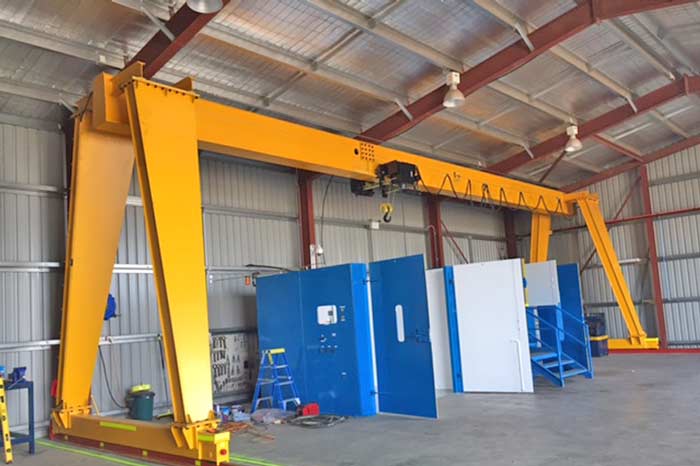
Features
Single girder gantry cranes excel in simplicity and efficiency:
- A single horizontal girder supports the hoist and trolley.
- Lightweight construction for easy mobility.
- Ideal for lower capacity applications.
Benefits
The advantages of single girder gantry cranes are abundant:
- Cost-effective solution: Perfect for light to moderate lifting needs.
- Suitable for space-restricted areas: Adaptable to facilities with limited headroom.
- Customizable for various operations: Manual or automated configurations.
Typical Applications
Single girder gantry cranes find their footing in numerous sectors:
- Warehouses: Efficiently handling materials in confined spaces.
- Construction sites: Lifting and positioning heavy construction materials.
- Manufacturing workshops: Aiding in assembly processes and equipment maintenance.
- Outdoor storage yards: Managing and moving materials in open environments.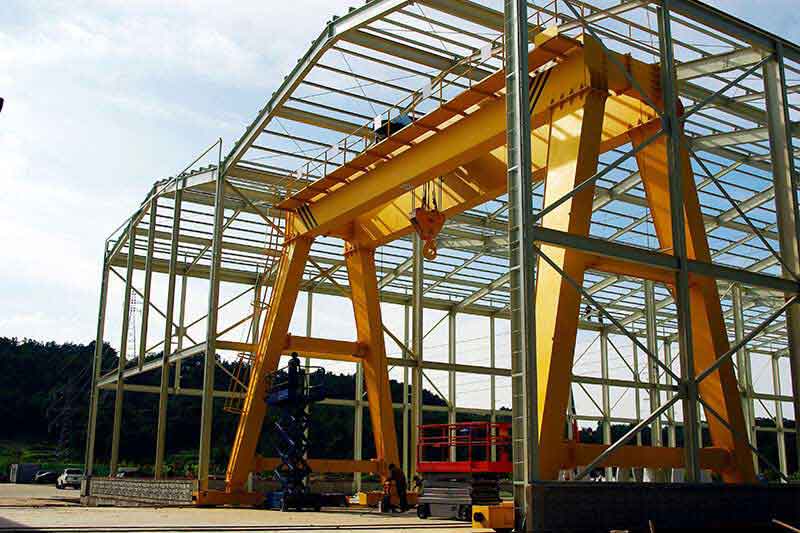
Features
Double girder gantry cranes elevate load-bearing capabilities:
- Two horizontal girders support the hoist and trolley.
- High load capacity and stability for heavy-duty lifting tasks.
- Designed for rugged industrial environments.
Benefits
These robust cranes offer a multitude of benefits:
- High load capacity: Ideal for heavy materials and equipment.
- Durability and resilience: Thrives in challenging industrial settings.
- Versatility for complex tasks: Handling large and intricate loads with ease.
Typical Applications
Double girder gantry cranes are the backbone of industries that demand sheer strength:
- Ports and shipyards: Managing cargo loading and unloading.
- Steel mills: Precisely handling massive steel components.
- Container handling: Ensuring efficient container operations.
- Heavy machinery production: Facilitating equipment assembly.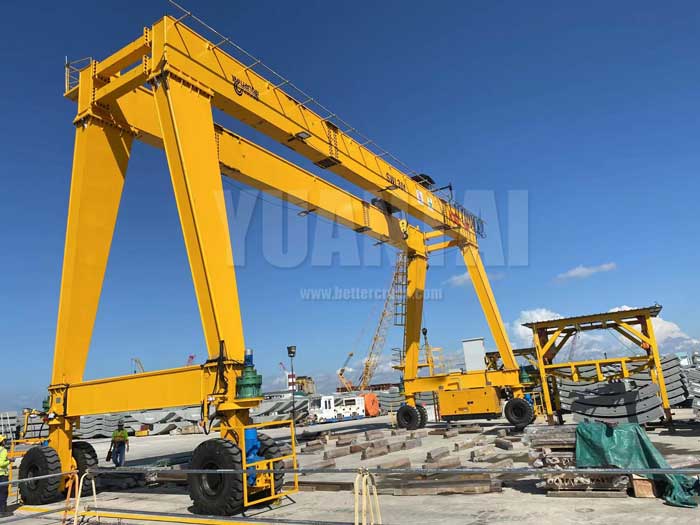
Rubber-Tired Gantry Cranes (RTGs)
Features
Rubber-Tired Gantry Cranes (RTGs) offer mobility and adaptability:
- Mobile cranes mounted on rubber tires for easy movement.
- Commonly used in container handling at ports and intermodal yards.
- Electrically powered with remote operation capabilities.
Benefits
The advantages of RTGs extend to multiple domains:
- High mobility and flexibility: Handling containers in dynamic environments.
- Efficient use of space: Streamlining container terminal operations.
- Reduced emissions and noise: Environmentally friendly compared to diesel-powered counterparts.
Typical Applications
RTGs are indispensable in transportation and logistics hubs:
- Container terminals: Managing container stacking and retrieval.
- Intermodal yards: Streamlining the transfer of freight between modes of transport.
- Freight handling facilities: Ensuring efficient and sustainable cargo operations.
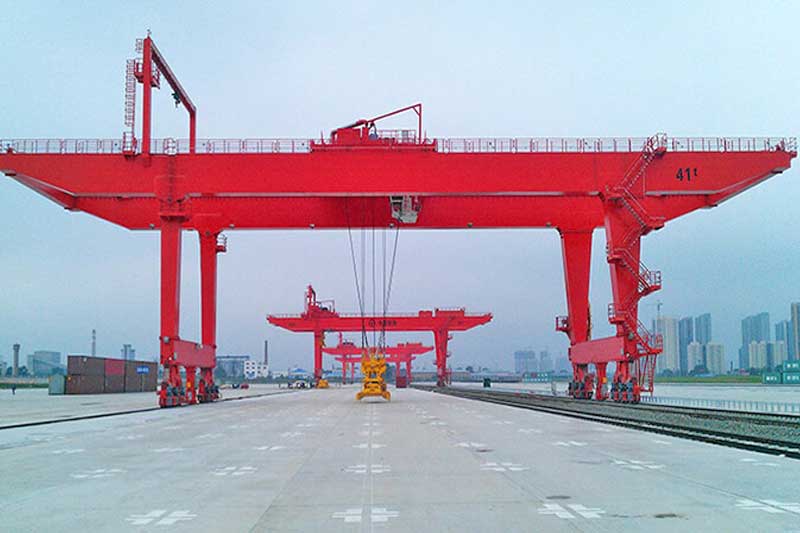
Rail-Mounted Gantry Cranes (RMGs)
Features
Rail-Mounted Gantry Cranes (RMGs) excel in precision and automation:
- Cranes running on rails for precise movement and positioning.
- Commonly used in container yards and automated storage systems.
- Equipped with advanced automation and computerized control systems.
Benefits
The advantages of RMGs transform container handling operations:
- Precise and efficient container stacking and retrieval.
- High-speed operation and automation capabilities.
- Maximization of storage space in container terminals.
Typical Applications
RMGs are pivotal in the efficient management of container terminals:
- Container yards: Ensuring efficient stacking and retrieval of containers.
- Automated warehouses: Optimizing storage and retrieval of goods.
- Intermodal facilities: Streamlining the transfer of freight between transport modes.
The world of gantry cranes is diverse and dynamic, providing solutions for a multitude of material handling needs. As we explore these crane types, their features, benefits, and typical applications, we gain a deeper appreciation for their pivotal role in modern industries.
Comparing Costs and Pricing Factors
In the realm of overhead cranes, cost considerations play a pivotal role in decision-making. The investment in a crane system involves a blend of immediate costs and long-term benefits. Let's delve into the factors that influence crane costs and explore the price ranges for different crane types.
Factors Influencing Crane Costs
Load Capacity, Span, and Features
The cost of an overhead crane is profoundly influenced by its specifications:
- Load Capacity: The crane's ability to lift and handle heavy loads directly impacts its cost. Higher load capacity cranes require more robust components, resulting in a higher initial investment.
- Span: The span, or distance between the runway beams, determines the crane's coverage areA longer span necessitates more structural components, affecting overall costs.
- Features and Customization: The inclusion of specialized features, automation, and customization to meet unique requirements can significantly increase crane costs. These features can enhance safety, efficiency, and productivity, justifying the investment.
Customization and Specialized Requirements
The degree of customization and any specialized requirements also contribute to the final price:
- Customization: Tailoring the crane to specific industry needs may involve additional engineering and design work, impacting costs.
- Environmental Considerations: Cranes designed for hazardous or corrosive environments may require special coatings, materials, or safety measures, adding to expenses.
- Automation and Technology: Integrating advanced automation and technology features, such as remote monitoring or anti-collision systems, can increase initial costs but offer long-term benefits in efficiency and safety.
Price Ranges for Different Crane Types
Budget Considerations
When it comes to selecting the right crane, budget considerations are paramount:
- Single Girder Bridge Cranes: These typically fall within the lower to mid-range price category, making them an affordable option for small to medium-sized businesses with moderate lifting needs.
- Double Girder Bridge Cranes: Due to their higher load capacity and durability, double girder cranes often come with a mid-range to upper-range price tag, catering to industries with substantial material handling requirements.
- Gantry Cranes: Gantry cranes, including both single and double girder types, offer versatility and mobility. Prices can vary widely depending on size and capacity, ranging from mid-range to high-end, but they provide value through adaptability.
Long-Term Cost Savings
While upfront costs are essential, it's crucial to consider long-term cost savings:
- Efficient Operation: Advanced features, automation, and precise load handling can lead to increased efficiency, reducing labor costs over time.
- Safety: Investments in safety features, such as anti-collision systems and advanced operator training, can reduce the risk of accidents and associated costs.
- Maintenance: Quality cranes may require less frequent maintenance, resulting in lower ongoing expenses.
- Durability: Investing in a durable crane that lasts longer can lead to cost savings over its lifespan.
Choosing the right crane involves a delicate balance between upfront costs and long-term benefits. Understanding the factors influencing crane costs and the price ranges for different crane types empowers businesses to make informed decisions that align with their budget and operational needs.
Addressing Top Concerns of Crane Users
In the world of overhead cranes, safety, maintenance, and operator competence are paramount concerns. Addressing these concerns not only ensures the well-being of personnel but also contributes to the efficient and reliable operation of crane systems. Let's explore these critical areas in detail.
Safety Measures and Compliance
Regulatory Standards and Best Practices
Safety is non-negotiable when it comes to overhead crane operations. Key aspects include:
- Regulatory Standards: Adhering to local, national, and international safety standards and regulations is imperative. These standards provide guidelines for crane design, operation, and maintenance to ensure safe practices.
- Best Practices: Implementing best practices in crane safety, including regular inspections, load capacity adherence, and safety feature utilization, is essential.
Ensuring Operator and Workplace Safety
Ensuring safety requires a holistic approach:
- Safety Equipment: Outfitting cranes with safety features such as limit switches, emergency stop buttons, and anti-collision systems enhances workplace safety.
- Operator Training: Thorough operator training is crucial, ensuring they understand crane operations, safety procedures, and emergency protocols.
- Workplace Safety: Maintaining a safe work environment includes clear signage, designated walkways, and proper load handling techniques.
Maintenance and Service
Preventive Maintenance Strategies
Preventive maintenance is the cornerstone of crane longevity and safety:
- Scheduled Inspections: Regular inspections help identify potential issues before they become critical. These inspections encompass structural, electrical, and mechanical components.
- Lubrication and Cleaning: Proper lubrication and cleaning of crane components reduce wear and tear, ensuring optimal performance.
- Replacement of Worn Parts: Timely replacement of worn or damaged parts is essential to prevent accidents and maintain efficiency.
Maximizing Crane Lifespan
Efforts to extend crane lifespan offer long-term benefits:
- Quality Components: Investing in high-quality components during crane construction can prolong its operational lifespan.
- Condition Monitoring: Implementing condition monitoring systems can detect early signs of wear or damage, allowing for timely maintenance.
- Upgrades and Retrofits: Crane upgrades, including modernizing controls and safety features, can extend its useful life and enhance performance.
Operator Training and Certification
Skills and Training Programs
Operator competence is a linchpin of crane safety:
- Structured Training: Providing structured training programs that cover crane operations, safety protocols, and troubleshooting is essential.
- Certification: Encouraging operators to obtain relevant certifications ensures they meet industry standards for competence.
Enhancing Operator Competence
Ongoing development is key:
- Continual Education: Promoting ongoing learning and skill enhancement keeps operators updated on the latest technologies and safety practices.
- Simulators and Training Aids: Using crane simulators and training aids allows operators to practice without real-world risks.
Addressing these top concerns fosters a culture of safety and efficiency in overhead crane operations. It not only safeguards personnel but also contributes to the longevity and reliability of crane systems, ensuring they remain indispensable assets in the industrial landscape.
Frequently Asked Questions (FAQs)
Answers to Common Questions
Navigating the world of overhead cranes can be a complex endeavor. Here, we provide answers to some of the most frequently asked questions to help you make informed decisions regarding your crane needs.
How do I choose between a bridge crane and a gantry crane?
Choosing between a bridge crane and a gantry crane depends on several factors:
- Workspace: Consider the available space in your facility. Bridge cranes are typically installed indoors, while gantry cranes are mobile and can be used both indoors and outdoors.
- Load Capacity: Determine the weight of the materials you need to lift. Bridge cranes and gantry cranes come in various load capacities, so select one that matches your requirements.
- Mobility: Gantry cranes offer more mobility, making them suitable for diverse work environments.
- Application: Evaluate your specific material handling needs. Bridge cranes are often used for precise indoor tasks, while gantry cranes excel in outdoor or flexible applications.
What are the cost considerations when investing in an overhead crane?
Crane costs depend on various factors, including load capacity, span, features, and customization. Consider the following cost considerations:
- Load Capacity: Higher load capacity cranes are generally more expensive.
- Span: A longer span requires more structural components, impacting costs.
- Features: Specialized features and automation can increase the initial investment but offer long-term benefits.
- Customization: Tailoring the crane to unique requirements may involve additional costs.
- Maintenance: Budget for ongoing maintenance to ensure the crane's longevity and safety.
How can I ensure the safety of crane operations in my facility?
Safety is paramount in crane operations. Implement these measures:
- Regulatory Compliance: Adhere to safety regulations and standards relevant to your industry.
- Operator Training: Ensure operators are well-trained, certified, and familiar with safety protocols.
- Safety Features: Equip cranes with safety features such as limit switches, emergency stop buttons, and anti-collision systems.
- Maintenance: Schedule regular maintenance and inspections to identify and address safety concerns.
- Workplace Safety: Maintain a safe working environment with clear signage, designated walkways, and safety barriers.
What maintenance practices are essential to keep my crane running smoothly?
Maintaining your crane is crucial for optimal performance and longevity. Essential maintenance practices include:
- Scheduled Inspections: Regularly inspect structural, electrical, and mechanical components.
- Lubrication: Properly lubricate moving parts to reduce wear and friction.
- Replacement of Worn Parts: Timely replacement of worn or damaged parts.
- Condition Monitoring: Implement condition monitoring systems to detect issues early.
- Upgrades: Consider modernizing controls and safety features to extend the crane's useful life.
What are the operator training requirements for crane operation?
Operator training is essential for safe crane operation:
- Structured Training Programs: Provide comprehensive training programs that cover crane operations, safety procedures, and troubleshooting.
- Certification: Encourage operators to obtain relevant certifications to ensure they meet industry standards for competence.
- Continual Education: Promote ongoing learning and skill enhancement, keeping operators updated on the latest technologies and safety practices.
- Simulation Training: Utilize crane simulators and training aids to allow operators to practice without real-world risks.
Addressing these common questions and following best practices ensures safe and efficient crane operations in your facility.
Conclusion
As we draw the curtain on this comprehensive guide to overhead cranes, we leave you with invaluable insights into the world of material handling and the pivotal role that cranes play in modern industries. From choosing between bridge and gantry cranes to addressing concerns about costs, safety, maintenance, and operator training, we've provided a roadmap to empower you in making informed decisions.
Making the Informed Choice: Bridge or Gantry Crane
The choice between a bridge crane and a gantry crane hinges on your specific needs. Bridge cranes excel in precise indoor operations, while gantry cranes offer mobility and flexibility, making them suitable for both indoor and outdoor applications. Consider factors such as workspace, load capacity, mobility, and application to determine the right fit for your material handling requirements.
Partnering for Your Crane Needs: A Trusted Manufacturer's Perspective
At Yuantai Crane, we understand that selecting the ideal overhead crane is a critical decision. As a trusted manufacturer and supplier, we're committed to providing tailored solutions that meet your unique needs. Our extensive expertise, commitment to safety, and dedication to innovation ensure that we stand by your side as you navigate the complexities of the industrial landscape.
Whether you're looking to enhance efficiency, boost safety, or streamline your material handling processes, we're here to help you achieve your goals. We believe that with the right crane and the right partner, your operations can reach new heights of productivity and success.
Thank you for entrusting us with your journey through the world of overhead cranes. If you have any further questions or require assistance, please don't hesitate to reach out. Together, we can lift your business to greater heights.
Reach Out to Us for Your Crane Solutions
We're here to help you find the perfect crane solution for your unique needs. If you have questions, need further information, or want to discuss your specific material handling challenges, don't hesitate to reach out. Our team of experts is ready to assist you every step of the way.
Explore Our Comprehensive Crane Product Line
Discover our extensive range of high-quality cranes designed to meet the demands of various industries. From bridge cranes to gantry cranes, we offer a diverse selection to ensure you find the right fit for your operations. Explore our product line and experience the innovation and reliability that have made us a trusted name in the crane industry.
Contact Yuantai Crane today to elevate your material handling capabilities and take your business to new heights. We look forward to partnering with you on your crane journey.




